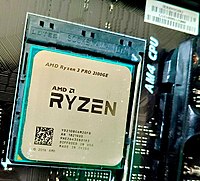
Photo from wikipedia
BACKGROUND Limited data are available regarding the prediction for functional recovery using late gadolinium enhanced magnetic resonance imaging (LGE MRI) after coronary revascularization for chronic total occlusion (CTO PCI). METHODS… Click to show full abstract
BACKGROUND Limited data are available regarding the prediction for functional recovery using late gadolinium enhanced magnetic resonance imaging (LGE MRI) after coronary revascularization for chronic total occlusion (CTO PCI). METHODS We studied 59 patients (mean age, 66±11 years) who underwent successful CTO PCI. Two-dimensional echocardiography and strain measurements were performed before and 8±2 months after CTO PCI. The findings of segmental assessment were compared with the extent of LGE MRI using a 16-segment model. RESULTS From baseline to follow-up, ejection fraction (54.2±12.1% to 56.1±10.6%, p=0.010), global longitudinal strain (LS) (-15.1±5.1 to -16.7±5.1, p<0.001), global circumferential strain (CS) (-14.0±4.9 to -15.9±4.9, p<0.001), and wall motion score (WMS) index (1.45±0.53 to 1.33±0.39, p=0.014) significantly improved. In the territory of the CTO vessel, LS and CS significantly improved in segments of LGE ≤50%, but not in segments of LGE >50%. However, WMS improved only in segments of LGE 1-25%. At baseline and at follow-up, CS allowed better discrimination of segments of LGE >50% than WMS [at baseline; area under the curve (AUC) 0.79 vs. 0.68, respectively, p=0.001: at follow-up; AUC 0.84 vs. 0.69, respectively, p<0.001). Discriminatory ability of LS for segments of LGE >50% significantly improved from baseline to follow-up (AUC 0.73 vs. 0.83, p<0.001). CONCLUSIONS The cut-off value of the extent of LGE MRI is 50% to detect segments that will functionally recover after CTO PCI. Change in LS was more sensitive for removal of ischemia by CTO PCI, indicating the utility of LS to monitor the therapeutic effects of CTO recanalization.
Journal Title: Journal of cardiology
Year Published: 2017
Link to full text (if available)
Share on Social Media: Sign Up to like & get
recommendations!